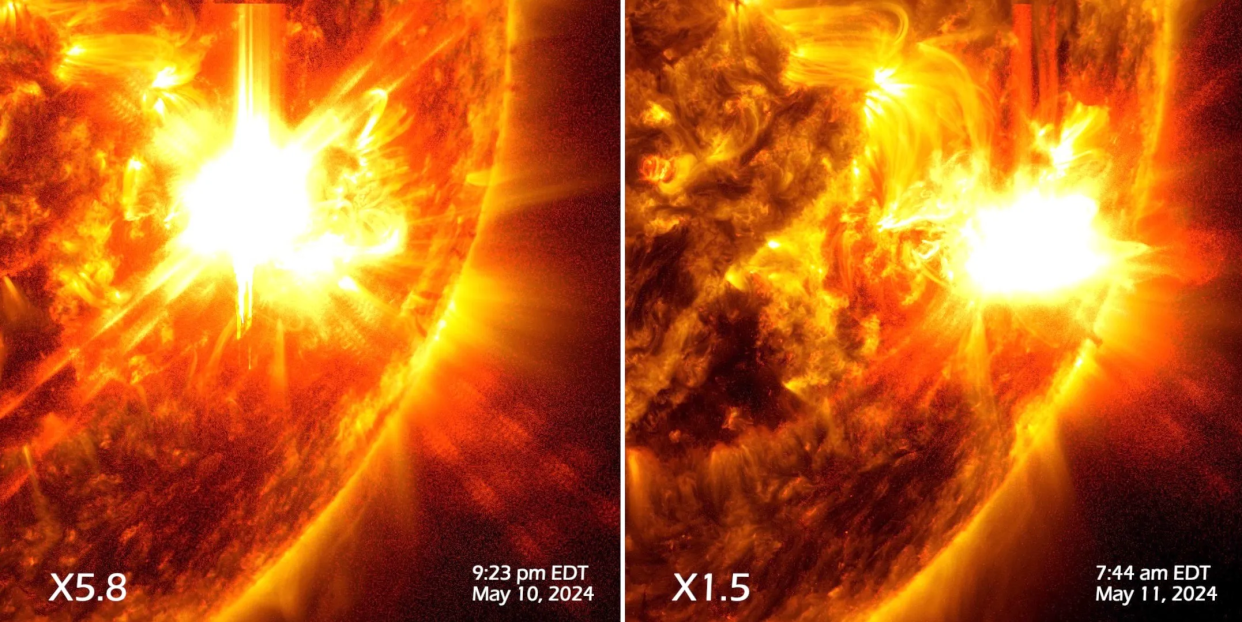The stormy sun erupts with its biggest solar flare yet from a massive sunspot — and it's still crackling (video)

Just when we thought we'd seen the most powerful flares from a colossal sunspot, the sun unleashed its strongest eruption of the weekend yet, triggering a radio blackout even as the star continues to crackle with solar storms.
According to NOAA's Space Weather Prediction Center (SWPC), the dynamic solar flare occurred late Saturday (May 10) from an active sunspot region called AR3664. It peaked at 9:23 p.m. EDT (0123 May 11 GMT), registering as a massive X5.8 class flare, SWPC officials said. As a result, parts of some of the Earth's sunlit side had temporary or complete loss of high frequency (HF) radio signals.
The sun, proving that it wasn't done yet, also fired off a powerful X1.5 solar flare at 7:44 a.m. EDT (1144 GMT), NASA officials said. X-class flares are the strongest types of solar eruptions from the sun, and while flares can last anywhere from a few minutes to hours, to get these high magnitudes aren't as common. Yet, the sun has fired off a series of powerful flares this week that have supercharged Earth's northern lights displays.

RELATED STORIES:
— Behemoth sunspot AR3664 unleashes its biggest solar flare yet
— Sun explodes in a flurry of powerful solar flares from hyperactive sunspots (video)
— Wild solar weather is causing satellites to fall. It's going to get worse.
"Solar flares are powerful bursts of energy," NASA wrote in a statement on the flares. "Flares and solar eruptions can impact radio communications, electric power grids, navigation signals, and pose risks to spacecraft and astronauts."
According to the recent NOAA SWPC discussion, region 3664 has the potential to stay busy through Monday (May 13). High to very high levels of solar activity are expected with an increased likelihood for more flares in the top two classes, M and X. The active region is a massive sunspot complex about 17 times the width of Earth, NOAA SWPC officials said.
Related: Jaw-dropping northern lights from massive solar flares amaze skywatchers

Sony A7III was $1799.99, now $1498
Sony’s third incarnation of the game-changing Sony A7 camera, the Sony A7III is lightweight yet packs a punch. With 4K HDR video, this camera is often used to capture videos of the Northern Lights. Right now, you can find it on sale for 17% off at Amazon. Check out our Sony A7III review.
Scientists have also noted that there was a coronal mass ejection (CME), a large expulsion of plasma and magnetic field, from the main eruption, which they are analyzing and modeling. This could bring additional impacts to Earth in the coming days including issues with power grids, telecommunication networks, and to satellites in orbit as well as another opportunity for a charged-up view of the northern lights for some locations!
Editor's note: If you capture a stunning photo or video of the northern lights (or southern lights!) and want to share them with Space.com for a possible story, send images, comments on the view and your location, as well as use permissions to spacephotos@space.com.

